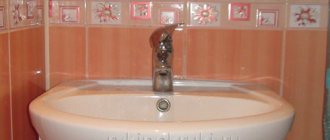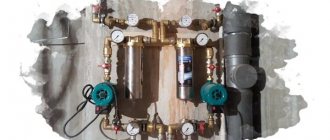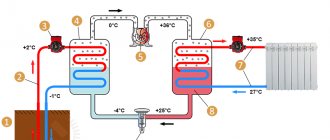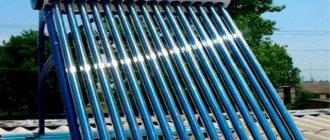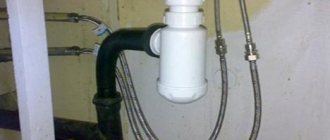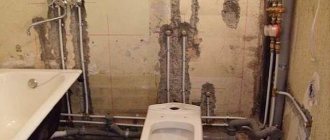Residents of the upper floors of high-rise buildings often experience the problem of insufficient water pressure in the pipeline. This creates a number of inconveniences. Insufficient pressure in pipes can lead to failure of expensive household appliances. For this reason, many are forced to wonder: how to increase water pressure in an apartment.
Normal pressure on the mixer
Why is low pressure unacceptable?
Insufficient pressure in an apartment can cause a number of troubles:
- breakdown of the washing machine and dishwasher;
- ineffective operation of the hydromassage box and drinking water filter;
- failure to turn on the instantaneous water heater;
- slow filling of the bathroom and toilet cistern.
As for the disadvantage of slow filling of the bathroom and toilet tank, this can still be tolerated, but low water pressure in the pipes can cause damage to household appliances. If the pressure drops below 2 atmospheres, the washing machine and dishwasher may fail if there is no special protection. If they don’t break, they simply won’t turn on until the pressure is restored. The inability to wash clothes in a machine forces you to do it manually, which is completely unacceptable. In addition, instantaneous water heaters, in particular gas water heaters, refuse to start if there is insufficient pressure.
Poor pressure on the faucet
Preventive measures
To prevent the problem of insufficient water pressure from arising, it is necessary to apply preventive measures.
A good practice would be to install pressure gauges along the entire length of the pipeline - near the pipeline entrance to the house, near branches and near consumer appliances.
This will allow you to promptly detect a decrease in pressure and quickly find out the cause of the problem. Also, filters should be regularly checked for contamination and, if necessary, cleaned.
What allows you to increase the pressure in the system
In order for the pressure in the water supply system to be higher, you must first understand the reasons that led to such troubles. The root of the problem may be:
- leaks and breaks in pipes on the main line;
- reduction in the cross-section of the pipeline as a result of the layering of calcium salts;
- filling the coarse filter;
- meter jamming;
- breakdown of shut-off valves or check valve.
An example of clogged old pipes
If there is poor water pressure, first of all you need to contact your neighbors living on the same floor. If everything is fine with them, then you need to look for the problem yourself. Additionally, if the system allows, you can partially dismantle the water main at the entrance to the apartment, having previously closed the shut-off valves. This will help assess the pressure. In this case, you will need to substitute a bucket or basin so as not to flood the floors. The absence of pressure at the inlet eliminates the need to maintain your part of the water supply. Then all that remains is to contact the emergency service so that they can take measures to repair the water pump, or install a pressure-increasing pump.
When the problem is caused by reasons within the apartment, the following actions will help:
- filter cleaning;
- washing aerators on faucet spouts;
- changing faucet cartridges;
- installation of new flexible hoses on taps and toilet cistern;
- reinstallation of the check valve;
- replacing the meter if it is jammed;
- complete replacement of the distribution of old pipes running from the riser to the apartment's consumption points.
Prices for cleaning clogs in the kitchen
Products for cleaning clogs in the kitchen
Boiler with two outlets
Circulation pump for hot water supply - from an indirect heating boiler without outlet for recirculation
To obtain a stable temperature in the DHW circulation circuit, a three-way thermostatic mixer is used here. To lower the temperature of the water from the primary circuit (at the boiler outlet), he mixes water from the cold water supply into it; it also feeds the boiler, compensating for the consumption of hot water.
Mixing unit with thermostatic head
It’s interesting: the high temperature in the boiler tank is useful because it disinfects it, preventing the growth of bacteria and the appearance of a specific unpleasant odor in the water.
The optimal temperature for heating water with a boiler is 55-75 degrees
The optimal sequence of actions if there is a problem with part of the pipeline in the apartment
The proposed solutions require a lot of time to maintain the system. It is much easier to find the main cause and quickly eliminate it, thereby returning normal pressure. Sometimes you can find a problem area on a water supply by the humming sound. At a problem point where the flow of water slows down, a hum is created when the mixer is opened. If you listen, you can immediately diagnose the problem and not waste time on unnecessary maintenance.
When it is not possible to determine the cause by ear, you should begin servicing the system. The first thing you can do is clean the aerator at the tip of the faucets. Before this, if you unscrew their flexible connection, you can see the current of water supplied to the tap. If it is normal, then changing the valve axle boxes and washing the aerators will solve the problem.
This is what a clogged aerator looks like
When the reason is not in the taps and flexible connections, then you need to look for it at the level of the meter and other fittings. Ideally, immediately contact the management company to remove the seals from it. After their dismantling, you can begin full-fledged maintenance, which was not available before, since the seal wire prevents the disassembly of many important components.
Then you can proceed according to this scheme:
- Disassemble the coarse filter and wash or replace its mesh.
- Check the pressure before and after the meter, it may be jammed and should be replaced.
- In a similar way, evaluate the operation of the check valve and replace it if necessary.
- Conduct diagnostics of ball valves and, if they fail, replace them.
If all else fails, then the reason is the pipes, which will have to be changed. This requires a tool, so you will have to call a plumber. If you plan to install metal-plastic pipes, you can do the soldering yourself by renting the equipment. This service is offered in many major cities.
Ball valve, oblique filter and counter are problem areas accumulating calcium salts
Technical equipment to increase water pressure in an apartment
When the cause of problems with pressure is hidden outside the apartment, and contacting the management company does not produce results, then the only way out of the situation is by using mechanical methods to increase the pressure. You will need to install a pump with a hydraulic accumulator.
If the pipeline system in the apartment has no defects, and everything is caused by weak pressure supplied to the house, then installing a pump will be the only way out of the situation. An additional argument in favor of this solution is higher pressure on the lower floors.
Pressure booster pump system
Attention! If the flow from the tap is weak, a pump will help. When the water column does not reach at all, a pumping station will be required.
Having a lack of water pressure in the apartment, a pump or pumping station is installed in the system immediately after the meter. They allow you to increase the level of water pressure supplied directly to key consumers, such as a washing machine or dishwasher, bathtub, etc.
The pump for increasing the pressure directly in the apartment is small in size. Its dimensions can be no more than a liter jar. In the case where there is a big problem with pressure, a more massive pump is installed.
Powerful boost pump
The pumping station is the same pump, but additionally equipped with a hydraulic accumulator. This reservoir accumulates water and subsequently releases it. This eliminates the need to constantly start the pump when opening the tap briefly, for example, to fill the kettle. The pump and hydraulic accumulator can act as one unit. In this case, there is a platform on top of the reservoir to which the pump is screwed. In most cases, all equipment is purchased separately and installed together directly in the apartment.
Pumping station to increase pressure
Electric water pump prices
Electric water pumps
Key parameters for pump selection
To obtain a sufficient level of water pressure in the apartment without creating problems for household appliances, you need to choose the right pump. First of all, you need to pay attention to its indicators:
- minimum water flow rate to turn on;
- maximum feed;
- operating pressure;
- cross-section of connecting elements.
The minimum water flow rate for switching on is very important. The fact is that non-sensitive pumps can only work if the mixer is opened at full power. Subsequently, when trying to reduce the flow, the pump stops. Ideally, the automatic pump should allow it to start at a flow of 0.12-0.3 l/min . An insensitive device will not pump up pressure when the toilet tank is filled, since it is connected through thin fittings and is filled with a low flow of water.
Video - Options for solving the problem of low pressure in the tap
The maximum flow shows how much water the pump can pump in a certain period of time. It can be defined in liters per second or minute, as well as cubic meters per hour. It is quite possible to purchase a weak pump, then the volume of pumped water will not be enough for the normal operation of all equipment and other points of consumption. To calculate the optimal pump performance, it is necessary to determine the consumption volume of all water intake points. The use of tabular data will help for this. It is necessary to summarize the indicators of all consumers, adding a power reserve for 10-30%.
Table 1. Water consumption at different water intake points.
| Name of water intake point | Average water consumption l/sec |
| Bathroom faucet | 0,1-0,2 |
| Toilet | 0,1 |
| Kitchen faucet | 0,1-0,15 |
| Dishwasher | 0,2 |
| Washing machine | 0,3 |
| Bidet | 0,08 |
The maximum pressure parameter is selected individually, based on the readings of the pressure gauge connected to the pipeline in the apartment. The optimal indicator is 2-4 atmospheres. That is, you need to choose a pump that creates a pressure level that is not enough to meet the norm.
Compact pump to increase pressure in an apartment
The final key selection criterion is the cross-section of the connecting elements. Since the pump fits into the pipeline, it is ideal that all fittings match the size of the existing pipes. Incompatibility will require the purchase of additional adapters, which is accompanied by unnecessary costs.
Comparison table of characteristics
The table below lists the main characteristics of the pump models under consideration. By comparing them with each other, it will be much easier for you to choose a model that ideally meets your needs and wishes at work.
| Model name | View | Operating modes | Peculiarities |
| Jemix W15GR-18 A | increase in cold water supply pressure | 2 | best price-quality ratio |
| Gilex Jumbo 60-35 P-K | designed to increase the pressure of cold water supply | 2 | high motor power |
| Wilo PB-201EA | designed to work with cold water supply | 2 | high quality and reliable assembly |
| Wilo Star RS 25/4-180 | hot water recirculation device | 1 | presence of speed switch |
| Valfex VPA 15-90 | hot water circulation | 1 | cheap but reliable device |
| Valtec Vsb 04-15 | hot water supply | 1 | low energy consumption |
| Grundfos UPA 15-90 | heating systems | 2 | high motor power |
Pump installation
A compact pressure booster pump used in apartments can increase the pressure by 1.5 atmospheres. This will be more than enough to operate any equipment. Those devices that are sensitive to low pressure are connected directly in front of the pump itself, which eliminates loss of pressure on the taps or toilet tank.
The simplest diagram of installing a pump in the system
The pump installation process is performed in the following order:
Step 1. Shut off the water at the entrance to the apartment.
We turn off the water in the apartment
Step 2. Cutting out a section of pipeline to fit the length of the pump pipe, taking into account fittings.
Cutting out an area for installing the pump
Step 3. Equipping the pipes with ball valves on both sides.
Installing ball valves
Step 4. Connecting the pump to the system using squeegees or American connectors.
Installing the pump
Step 5. Checking the tightness.
Step 6. Electrical installation of the pump through an RCD.
Connecting the pump
Important! There is an arrow on the pump body indicating the direction of water injection. It is necessary to install it towards the apartment so that water is drawn in from the riser.
Installation requires specialized tools. If cold water is supplied using polypropylene pipes, then the insertion is made with special scissors. The steel pipeline is cut with a grinder or a hand saw.
An example of the correct placement of a pump in an apartment
To connect the fitting to a plastic pipe, soldering is carried out. In houses with metal pipelines, you will need a die for cutting threads. Its diameter depends on the type of system, but will usually be 2/4 or 3/4 inches .
What does the water supply network of a high-rise building consist of?
The water supply system of an apartment building is one of the most complex engineering objects, representing a voluminous branched complex of interconnected elements, components and mechanisms that serve to supply water to consumers. It is divided into external (external) and internal water supply networks.
- External networks are all elements of the water supply system laid outside the building. External water supply systems consist of water intake units, inspection wells, water treatment systems, treatment devices, a pumping station and, directly, a pipeline. External networks are serviced by resource supply organizations in the housing and communal services sector - water utilities and heat supply companies.
- Internal networks are located inside the structure and provide water supply from the external water supply to consumers in the apartments. The in-house water supply system is delimited by certain areas of responsibility between the management company and the owner of residential property. The structure of the internal water supply network section includes a complex of pumping equipment, intra-house and apartment pipe distribution, mains, risers, filtration systems, as well as various types of fittings: water taps, shut-off and control valves.
The best option for residents of an apartment building is to supply water from a central water supply - a centralized water supply can provide unlimited amounts of water resources to a large number of consumers.
Installation of a pumping station
What to do if there is poor water pressure in a private house?
If the system periodically has no water at all, then the pump will be an ineffective solution. In this case, a pumping station will help get out of the situation. In addition to an ordinary pump to increase pressure, it also includes a hydraulic accumulator. It is a cylindrical tank that accumulates water while it is in the system. There is a rubber membrane inside it. Pressure expands it, and when there is no pressure, it is compressed as a result of natural elasticity and squeezes out the accumulated water.
Hydraulic accumulator membrane design
Installing a system with a hydraulic accumulator is a little more complicated, but the scheme for apartments with poor pressure is still quite simple. After inserting into the pump pipeline, the tube coming out of it is equipped with a cross. Its second end is connected to the hydraulic accumulator, and the third goes to the apartment. A pressure switch is usually installed on the unplugged part of the cross, which controls the operation of the pump.
Efficient station installation scheme
The water supplied from the pump, with the taps closed, the toilet fittings covered and the absence of intake from household appliances, will accumulate in the tank. As soon as the pump raises the pressure to the limit point, it automatically turns off. If the mixer is opened, water will begin to flow from the accumulator as a result of squeezing out by the membrane. The flow coming out of it will not be able to return to the riser, since this requires passing through a check valve, which is impossible. When the pressure drops, the automation will turn on the pump, and it will again restore the tank's supply.
Choosing such a system requires finding a place to install a hydraulic accumulator. The pump itself is very compact, but the reservoir takes up space. Ideally, choose a container of such a volume that the water in it is enough for a day. This will allow you not to experience discomfort even if the water pump is being repaired when the water is turned off in the entire house.
Design Features
For DHW circulation, centrifugal pumps with a “wet” rotor are mainly used. The operating principle of such a circulation pump is quite simple.
- Water entering the chamber of the recirculation pump through the inlet pipe is captured by the blades of the impeller, which is rotated by the drive motor shaft.
- Centrifugal force begins to act on the water, which throws it towards the walls of the working chamber, where increased pressure is created.
- Under the influence of pressure generated by centrifugal force, the liquid is pushed into the pressure line of the recirculation pump.
- The suction of the next portion of hot water into the working chamber occurs due to the fact that air rarefaction is created in the central part of such a chamber during the processes described above.
Design of a centrifugal circulation pump with a “wet” rotor
It should be borne in mind that a conventional centrifugal water pump is not suitable for heating and hot water supply, since the operating conditions of such equipment do not provide for a high temperature of the pumped liquid. For the manufacture of pumps that recirculate hot water, materials are used that are resistant to increased loads and high temperatures. In addition, such electric pumps, which operate primarily indoors, must be low-noise so as not to make living conditions in a private or apartment building uncomfortable. No less important characteristics of electric pumps for DHW circulation are compactness and efficiency in terms of electricity consumption.
When selecting pumping equipment that will need to work with hot water, you should also keep in mind that pumps for DHW recirculation differ in operating conditions from devices used to equip a heating system. Thus, pump models for a boiler room are designed to pump water whose temperature reaches 90°, while devices that circulate hot water can work with a liquid medium heated to 65°. As such, they are not interchangeable, although if necessary, an electric heating pump can be used to circulate hot water in DHW systems. However, replacing such devices cannot be done in the reverse order.
Domestic pumps are designed to recirculate water in small hot water systems
Options for controlling the operation of pressure-increasing equipment
Pressure increasing water pumps come in the following types:
- manual;
- auto;
- combined.
The hand pump is the cheapest unit. Once plugged into the outlet, it starts working until it is unplugged. It is better not to buy such a pump, because if you forget to turn it off, the winding of its motor will burn out. It is inconvenient to use such a pump. It needs to be turned on and off periodically, often reaching for an unsuccessfully located outlet or switch. For example, if a washing machine is running, the pump will have to work for several hours, since at any moment it may require additional water intake for rinsing. If the system has a hydraulic accumulator, then using a manual pump becomes more convenient.
Pump without automation
An automatic system is the best option because it eliminates the need for any manual operation. This equipment has a flow sensor. When the mixer is opened, the pump reacts, turning on pumping. Choosing such a device, although it will require you to spend more at the initial stage, reduces energy costs. The fact is that the equipment is turned on only when the faucet is opened, the toilet tank is filled or the washing machine is running; the rest of the time it is de-energized.
Pump with water flow sensor
Combined pumps operate in manual and automatic mode. Often there is no need to overpay for such a device, since there is no need for forced pumping. The pump is equipped with a flow sensor, so it will automatically determine when to start. Externally, such pumps can be identified by the presence on their body of a special switch with the inscriptions “automatic mode” and “manual mode”.
Video - Installing a pump in an apartment on the 5th floor
How to install
During installation, focus on several aspects:
- A part of the pipe is cut out in an accessible place in the water supply.
- The pump is installed in the designated part in accordance with the instructions.
- Additionally, the same pump is screwed to the threaded pipes - it becomes stronger.
To ensure that household appliances (boilers, washing machines and dishwashers) work correctly, the pump is placed in front of them. If the house has a storage tank, then the pumping system should be installed directly at the outlet of the tank. Be sure to follow the instructions, different types of pumps have special installation requirements. Otherwise, you will not get the desired result.
Options for placing pumps and pumping stations in the apartment
Often the apartment does not have enough space to allocate a small technical area where the boiler can be located, as well as pumping equipment to increase water pressure. In this regard, it is necessary to find a place where it is possible to install the pump. Usually it is located under the bathroom behind a retractable screen. Since there is little space there and it is not very convenient to work during installation, only a pump is installed without a hydraulic accumulator.
Pump under the sink without accumulator
In addition to this article, we recommend that you read the material on the topic – Adjusting the pressure of a pumping station, do-it-yourself pressure switch.
It is most convenient to operate and maintain these systems when they are located in a cabinet under the sink. Depending on where the riser is located, it could be a kitchen or a bathroom. If there is no space at all, then you can place a miniature pump only directly in front of an important consumer. This could be a washing machine or instantaneous water heater. The pumps used for this are very small in size and hardly exceed the size of a water meter.
Power connection
The circulation pumps operate from a 220 V network. The connection is standard; a separate power supply line with a circuit breaker is desirable. The connection requires three wires - phase, neutral and ground.
Circulation pump electrical connection diagram
The connection to the network itself can be organized using a three-pin socket and plug. This connection method is used if the pump comes with a connected power wire. It can also be connected via a terminal block or directly with a cable to the terminals.
The terminals are located under a plastic cover. We remove it by unscrewing several bolts and find three connectors. They are usually labeled (the pictograms are N - neutral wire, L - phase, and “ground” has an international designation), so it’s hard to make a mistake.
Where to connect the power cable
Since the entire system depends on the performance of the circulation pump, it makes sense to make a backup power supply - install a stabilizer with connected batteries. With such a power supply system, everything will work for several days, since the pump itself and the boiler automation “pulls” electricity to a maximum of 250-300 W. But when organizing, you need to calculate everything and select the battery capacity. The disadvantage of such a system is the need to ensure that the batteries do not discharge.
How to connect a circulator to electricity through a stabilizer
Hello. My situation, a 25 x 60 pump is located immediately after a 6 kW electric boiler, then the line from a 40 mm pipe goes to the bathhouse (there are three steel radiators) and returns to the boiler; after the pump, a branch goes up, then 4 m, down, rings a house of 50 sq. m. m. through the kitchen, then through the bedroom, where it doubles, then the hall, where it triples and flows into the boiler return; in the bathhouse there is a branch 40 mm up, it leaves the bathhouse and enters the 2nd floor of a house of 40 sq. m. m. (there are two cast-iron radiators) and returns to the bathhouse in the return line; there was no heat on the second floor; the idea of installing a second pump in the bathhouse for supply after the branch; the total length of the pipeline is 125 m. How correct is the solution?
The idea is correct - the route is too long for one pump.

